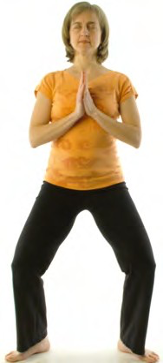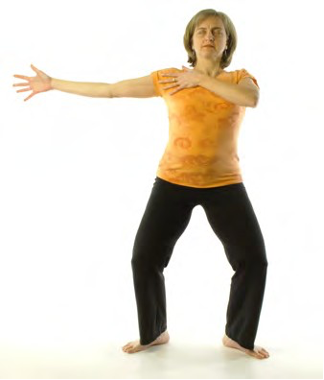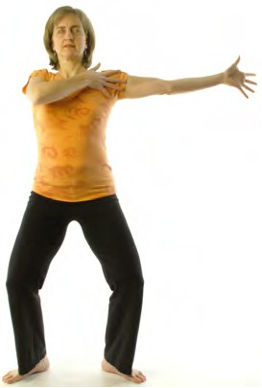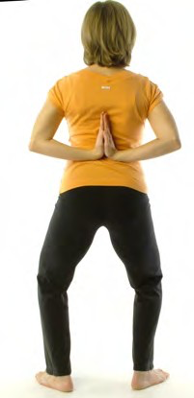Primary Objective of the Ásana
This ásana strengthens the legs and joints. It inspires spiritual ideation and helps with meditation. Bhávásana increases worldly understanding.
Repetitions (standard): 4
Length of pose hold (ideal): 8 seconds in each position
Breath: continuous






| Steps of practice | Rationale & further details |
| 1.- Bend your legs, keeping the feet slightly apart and pointing in opposite directions of about 90 degrees, keeping the heels hip-width apart. – Make sure that the knees point in the same direction as the toes when you bend the legs. -Feel equally rooted down through the four corners of the feet. | -Feet may be facing opposite directions but in a V formation, less than 90 degrees. -Keep your weight in the heels. – You might damage the ligaments of the inner knees if they point inward while bending. -Knees and toes MUST be aligned. |
| 2. – Roll the shoulders back and down, as you slightly open the chest. – With an inhalation. bring the hands together in front of the heart center in Namaskar Mudrá and focus your gaze at the center of the eyebrows (trikut’i) without raising the chin. – Breathe out and bend the knees keeping the tailbone down and pulled in as in Sahaja Utkat’a’sana. – Hold the position for 8 seconds, keeping the gaze on the trikut’i or a’jina’ chakra (the midpoint between the eyebrows). -Breathe continuously. There is no breath holding kumbhaka. | – Push the tailbone down to prevent a hyper-lordotic curvature in the lower back when the legs are bent. -The knees are bent as if sitting or in Sahaja Utkatásana. – The gaze at the center of the eyebrows makes the pose meditative and increases the ability to concentrate and ideate in meditation. If it is difficult, you can gaze at the tip of the nose. -Engage the abdominal muscles in Ud’d’ayana Bandha’. |
| 3. – On the next inhale, sweep the arms to the right side, letting the left hand touch the chest and slide across the right arm as far as possible, stopping on the front (inside) of the arm. -Hold this position for 8 seconds, keeping the gaze on the trikut’i. – Breathe continuously. There is no breath holding kumbhaka. -On the next inhalation, extend the arms to the left in the same manner and hold the position for 8 seconds, keeping the gaze on the trikut’i. Breathing continuously. 5.-On an inhale, bring the palms together in Namaskar Mudrá in front of the anáhata chakra or heart center. -On an exhale, swim both palms around the body in opposite directions, bringing the hands together behind the back in Namaskar Mudras position. – Hold the position for 8 seconds, gazing at the trikut’i. Breathing continuously. -On an inhale, bring palms together again in front of the aná’hata chakra or heart center. | -Left hand can touch the right shoulder. -When holding this position, the left arm may not be touching the chest but is as close as comfortable. -Keep the elbows straight. -Right hand is touching the left shoulder. -If it is not possible to bring the palms together behind the back, you can hold the elbows instead, or wrap the right hand around the left wrist behind the sacrum.See modifications. |
| 6. – Release the pose carefully. allowing your lower leg position to change. – This pose is practiced for four rounds.Rest for at least 10 seconds in between rounds. -After the last repetition rest in Tadasana or Shava’sana for a few breaths to integrate the effects of the posture and to let the body recover. | -Gaze at the trikut’i throughout the practice. -Before the next repetition you can cycle through some deep breaths keeping your palms in front of your eyes and relaxing the eyes as in the self-massage practice, to release the tension from the gaze. |
Preparatory Steps
- Shoulder circles or arm strengthening poses like Diirgha Pran’am/Long bowing pose or Karmásana/Action pose.
- Stretching the quadriceps as in Sahaja Utkat’a’sana/Simple Chair.
- Knee warm ups.
Considerations
Safety essentials
- It is essential to engage Mu’la’dha’ra and Uddiyana bandhas to help to keep the back straight, especially if the back is lordotic.
Common Misalignments
- Legs and feet are facing straight ahead.
- Arms or elbows are sagging or out too far from the body. Arms should be parallel to the floor with the elbows straight and close to the body.
- Eye position is incorrect.
- Back is not in a linear alignment. Sometimes the tailbone will sweep outwards.
Modifications
- Legs may be further than hip width apart.
- Feet can
- be in a V position, bringing the heels inward and the toes pointing outward.
- Hands can be behind the back pointing downwards near the sacrum or placed in the folds of the elbows.
Benefits
- Inspires worldly knowledge and spiritual ideation.
- Strengthens legs, knees, and joints.
- Helps one to be more grounded.
- Very helpful for meditation.
Visualizations & Ideations
- There are 4 major sections in this series. The ideation can be:
- 1) I am sending Peace to all Beings.
- 2) I am sending Life to all Beings.
- 3) I am sending Love to all Beings. 4)This is my Family. (return to original position)
- I am devoted to all beings as reflections of the Cosmic One.
- I seek only to please the Divine Consciousness.